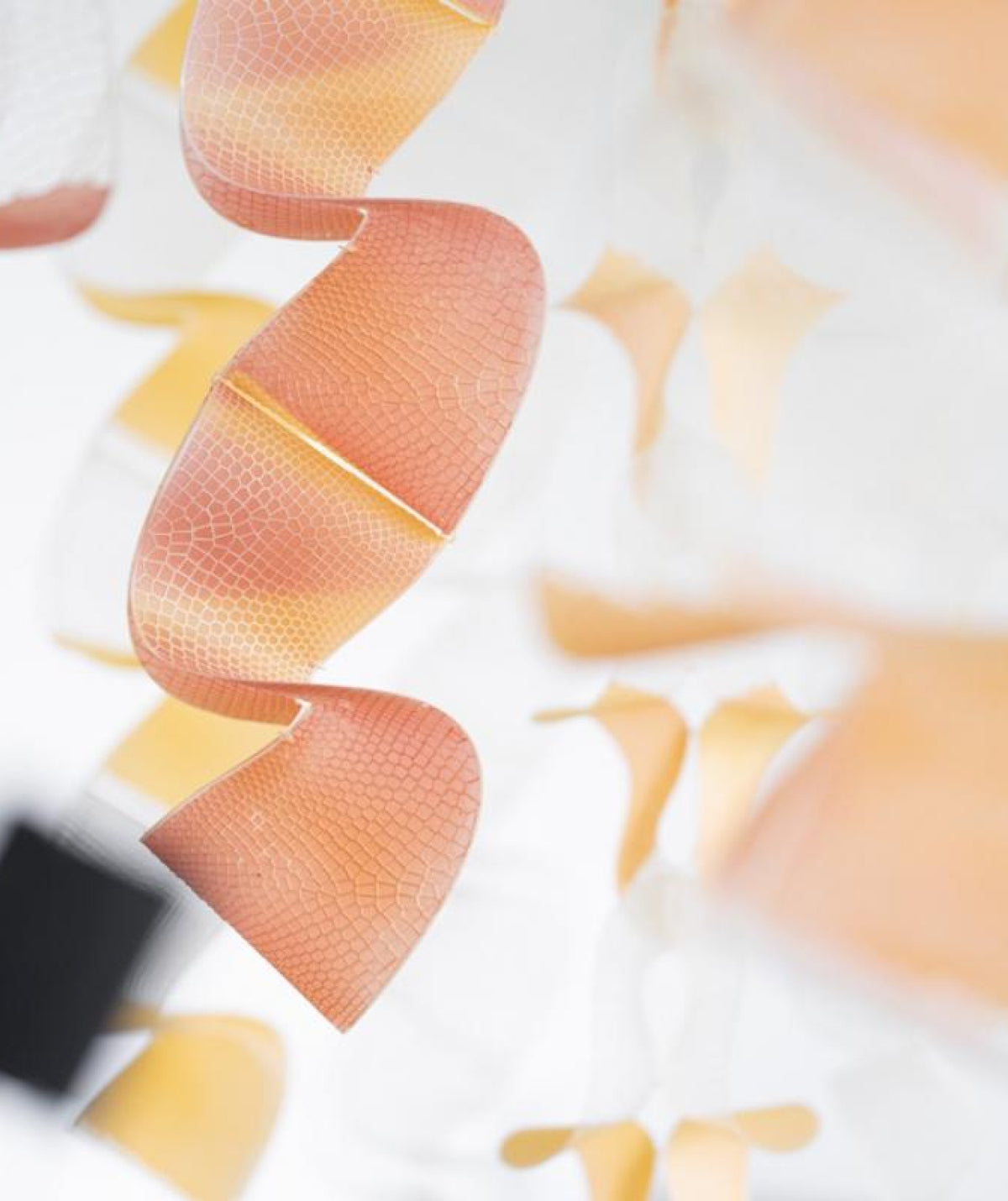Sensbiom 2


Year: 2023
Material: Nuatan® with UV bioskin
Series name: Collection 10, Sensbiom 2
Typology: Design Research
Collaborator: DumoLab Research
Showcased at Alcova, Milan Design Week 2023
SENSBIOM 2 is a playful installation that proposes a future where objects help humans reconnect with the planet using environmentally interactive materials derived from renewable resources. It is an outcome of crafting plastics! studio & DumoLab Research of their ongoing multidisciplinary collaboration on interactive biomaterials at Alcova 23, Milan Design Week, Italy.
Ultraviolet radiation (UVR) can neither be seen nor felt. The Global Solar UV index (UVI) that shows on our phone’s weather apps, was developed by the World Health Organization in 1994, and determines that a UVI higher than 3 can quickly damage skin and eyes. While highest rates of UV are closer to the equator, the city of Milan has a UVI of 6 in spring and alarmingly of 10 in summer. Twenty years ago chlorofluorocarbon emissions were banned to stop stratospheric ozone depletion, but today’s climate change caused by fossil fuel burning has a big impact on global UVR increase causing DNA damage to all living things.
In SENSBIOM 2 a collection of biopolymer lattices are able to change color evidencing UVR exposure by signaling real-time changes in solar radiation to make visitors aware of invisible threats harming 3 million people’s eyes and skin globally every year.

The project asks: How does radiation harm us? What is in the air we breathe? Can matter signal what humans cannot see? And perhaps respond to it or reverse it? What impact can our ecologically-active bio-composites have on humans and non-human health in a time of accelerating climate change? Can biomaterials help us heal our relationship with nature?
Sensbiom embodies ongoing research by designers and biologists at crafting plastics! studio and DumoLab Research as a multidisciplinary collaborative effort to explore senseable, biochemically-augmented, environmentally-active biomaterials, to map new relationships between humans and the ever-changing environment.
Project team: Vlasta Kubušová, Laia Mogas-Soldevila, Shivani Chawla, Abby Weinstein, Shuyao Geng, Youyang Song, Martina Bajteková, Soňa Otiepková, Lukáš Gál, and Miroslav Král. Light installation by: Alexander Kupko
Project support: methods and materials mainly funded by crafting plastics! studio and DumoLab Research, with partial support by Slovak University of Technology in Bratislava and by the University Research Foundation at Penn. Supported using public funding by Slovak Arts Council.
Ultraviolet radiation (UVR) can neither be seen nor felt. The Global Solar UV index (UVI) that shows on our phone’s weather apps, was developed by the World Health Organization in 1994, and determines that a UVI higher than 3 can quickly damage skin and eyes. While highest rates of UV are closer to the equator, the city of Milan has a UVI of 6 in spring and alarmingly of 10 in summer. Twenty years ago chlorofluorocarbon emissions were banned to stop stratospheric ozone depletion, but today’s climate change caused by fossil fuel burning has a big impact on global UVR increase causing DNA damage to all living things.
In SENSBIOM 2 a collection of biopolymer lattices are able to change color evidencing UVR exposure by signaling real-time changes in solar radiation to make visitors aware of invisible threats harming 3 million people’s eyes and skin globally every year.

The project asks: How does radiation harm us? What is in the air we breathe? Can matter signal what humans cannot see? And perhaps respond to it or reverse it? What impact can our ecologically-active bio-composites have on humans and non-human health in a time of accelerating climate change? Can biomaterials help us heal our relationship with nature?
Sensbiom embodies ongoing research by designers and biologists at crafting plastics! studio and DumoLab Research as a multidisciplinary collaborative effort to explore senseable, biochemically-augmented, environmentally-active biomaterials, to map new relationships between humans and the ever-changing environment.
Project team: Vlasta Kubušová, Laia Mogas-Soldevila, Shivani Chawla, Abby Weinstein, Shuyao Geng, Youyang Song, Martina Bajteková, Soňa Otiepková, Lukáš Gál, and Miroslav Král. Light installation by: Alexander Kupko
Project support: methods and materials mainly funded by crafting plastics! studio and DumoLab Research, with partial support by Slovak University of Technology in Bratislava and by the University Research Foundation at Penn. Supported using public funding by Slovak Arts Council.





